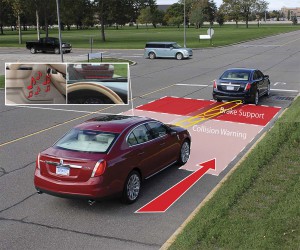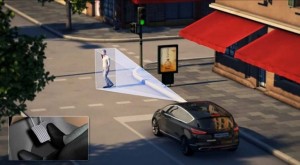Calling it “a win” for consumers,” U.S. Transportation Secretary Anthony Foxx confirmed that virtual all new cars, trucks and crossovers sold in the U.S. will be equipped with automatic emergency braking by September 2022.
A total of 20 major automakers, representing about 99% of the vehicles sold in the U.S., participated in a first-of-its-kind industry-government consortium aimed at bringing the technology to market faster than would be possible going through the normal regulatory process. A recent study suggests auto braking can reduce the number of reported collisions it’s designed to prevent by as much as 40%.
“By proactively making emergency braking systems standard equipment on their vehicles, these 20 automakers will help prevent thousands of crashes and save lives,” said Transportation Secretary Foxx during a Washington, D.C. news conference Thursday. “It’s a win for safety and a win for consumers.”
(For more on today’s announcement, Click Here.)
Known variously as Emergency Auto Braking, Automatic Emergency Braking, or AEB, the technology uses laser, radar, cameras or all three to scan the road ahead of a vehicle. If the system detects a potential problem it will sound a warning to alert the driver to brake. If there is no reaction, the system will apply the brakes automatically. In many cases, that is enough to prevent a crash or at least reduce the severity of the impact.
The Insurance Institute for Highway Safety released a new study earlier this year indicating that auto braking reduced the number of police-reported rear-end collisions by as much as 40%.
“Deploying AEB on a wide scale will allow us to further evaluate the technology’s effectiveness and its impact on insurance losses, so that more insurers can explore offering discounts or lower premiums to consumers who choose AEB-equipped vehicles,” says IIHS Board Chairman Jack Salzwedel, who is also CEO of American Family Insurance.
(Ford, GM betting big on autonomous tech, mobility services. Click Here for more.)
Auto braking, as well as a less advanced technology called forward collision warning, have already become available on a number of vehicles, especially those in the luxury segment. But NHTSA has wanted to see such features become standard – and to do so more quickly than would be possible through the slow and laborious regulatory process.
That led to the creation of a special industry-government consortium last September involving ten major automakers. The consortium since grew to 20 makers, including Audi, BMW, Fiat Chrysler, Ford, General Motors, Honda, Hyundai, Jaguar Land Rover, Kia, Maserati, Mazda, Mercedes-Benz, Mitsubishi, Nissan, Porsche, Subaru, Tesla, Toyota, Volkswagen and Volvo.
“Volkswagen Group of America takes the safety of our passengers very seriously. We are proud to join the National Highway Traffic Safety Administration and the Insurance Institute for Highway Safety to make the commitment to make automatic emergency braking a standard feature on new cars starting in 2022,” the German maker said following the announcement.
Not everyone is quite as enthusiastic. Several safety groups have protested the plan. Long-time advocate Joan Claybrook, a former NHTSA Administrator, warned that the agreement will not result in the best possible application of auto braking. Critics have filed a petition asking NHTSA to go ahead with formal rule-making.
That may yet happen, but the government safety agency has struck out on a new direction that might be described as cautiously cooperative with the auto industry since the arrival of Administrator Rosekind in late 2014.
The former head of the National Transportation Safety Board, Rosekind points to the results of industry-government efforts to improve airline safety. He has set out a goal of driving down to zero the number of highway fatalities in the U.S., a figure that dropped to around 32,000 in 2014 but then rose an estimated 8% last year.
So-called active safety technologies, such as electronic stability control, have been hailed as a major factor in the push for safer roads. And even more advanced technologies are coming as the industry pushes to begin rolling out fully autonomous vehicles early in the coming decade.
The question is how to get such systems into mainstream vehicles as quickly as possible. Under Rosekind’s guidance, the AEB consortium has grown into a broader industry-government alliance announced at the Detroit Auto Show this past January. The goal is to now work cooperatively on other safety systems.
Participants, such as John Mendel, the top American executive for Honda, say that this may even see some makers share proprietary technology and intellectual property rights.
Rosekind has made it clear that the industry will continue to have the government breathing down its neck and it’s gotten what the administrator called a “big stick,” Congress authorizing a tripling of potential penalties for makers who violate safety rules as part of the recently enacted U.S. transportation bill.
(For more on the expanded auto safety consortium, Click Here.)


